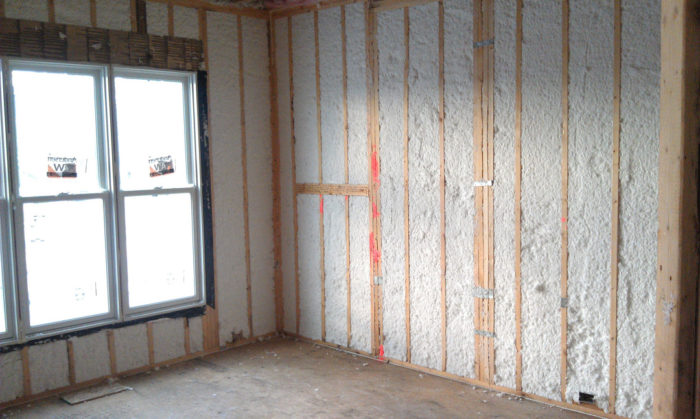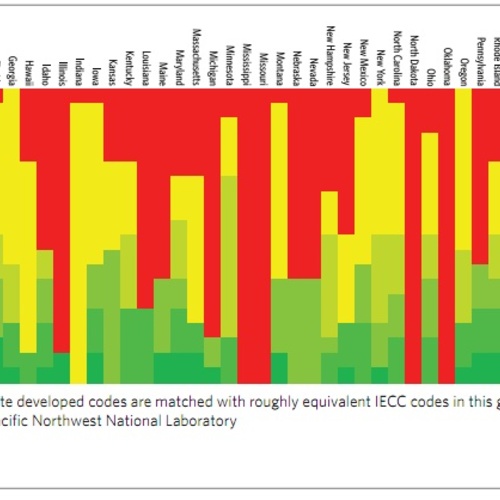
Image Credit: Jesus Rodriguez / CC BY 2.0 / Flickr
By LAUREN URBANEK
How much energy do building codes save over time? That’s the question that a new report released last week from the Department of Energy (DOE) aims to answer — and the answers show the results can be mammoth, both in terms of consumers’ utility bill savings and avoided carbon emissions.
The study underscores the importance of building codes for the nation’s energy and climate goals, by examining the national consequences of energy codes from 2010 to 2040. I’ve talked about the importance of developing strong model building codes in previous blog posts. But jurisdictions have to actually adopt those strong codes to realize the energy and carbon pollution savings.
The DOE found that, taking into account the fact that states adopt the model building codes at varying rates, energy codes with modest updates over the years could save consumers $126 billion on their utility bills from 2010 to 2040. This equates to a carbon pollution reduction of 841 million metric tons, equivalent to the greenhouse gases emitted by 177 million passenger vehicles driven for one year or the carbon dioxide emissions from 245 coal power plants for one year.
The projected energy savings from such code adoption are huge — nearly 13 quads (quadrillion BTUs). This is on par with the energy savings expected from the equipment efficiency standard adopted last year for commercial rooftop air conditioners, the largest single standard ever. Building codes may not be at the top of most consumers’ minds, but nonetheless, they save homeowners and business owners real money and energy.
A timely report
Paying attention to the high value of strong energy codes is especially at this time of year, because the International Code Council recently held its annual conference and public comment hearings in Kansas City. This is the next step in the development of the 2018 International Energy Conservation Code (IECC). The IECC is the model energy code recognized by the Department of Energy and cited in federal law, which is updated every three years through a stakeholder process. It’s then up to local jurisdictions to adopt and enforce the codes.
At the public comment hearings, building officials will vote to determine which proposals will be included in the final online voting ballot. The online voting process will then decide the proposals that will be incorporated into the final 2018 energy code.
Local building officials have a lot of power in this process — and they should use it! We urge code officials to get out the vote, in Kansas City if possible, but certainly through the online voting process (which will open online in early November). Information about how to vote, and which proposals will strengthen or weaken the code can be found on the Energy Efficient Codes Coalition website, which will be updated after the public comment hearings with a final voting guide. Building officials have the power to ensure that the code keeps saving energy for years to come.
What’s possible?
The DOE report based its savings projections on the Technological Roadmap reports produced by its Building Technologies Office (BTO) for various products. BTO researches progress and market trends and the office’s work helps to predict when different technologies are expected to be widely adopted. Using this information, DOE looked at projected technological advances in different end uses, and estimates that there should be about a 4% to 5% increase in stringency per code cycle for both the residential and commercial codes. This is a relatively cautious estimate of what is possible.
While DOE found that the 2015 residential IECC model building energy code saved only about 1% relative to the 2012 version (excluding the Energy Rating Index compliance path, which was new in 2015), the 2012 version saved 24% relative to the 2009 code, and the 2009 code saved 11% relative to the 2006 code.
DOE also considered that different jurisdictions adopt the code at different times. While some states, like Maryland and Massachusetts, are statutorily obligated to adopt the most recent version of the code within a set timeframe (generally within a year of publication), other states have a lag time between model code development and local adoption. For analysis purposes, DOE assumed either a 1-year or a 7-year delay for these states. This is a very realistic assumption and is accounted for in the immense savings I noted earlier.

Savings levels aren’t just about how quickly states adopt the code, though — they also depend on how well builders comply with it. DOE found that the earliest adopters of the latest model building code often don’t fully realize the code’s potential savings right away. This makes sense — often, new building codes include cutting-edge construction practices, which may take some time for builders to learn and put into practice.
DOE accounted for this by assuming a conservative 80% realization rate for the first year of savings after a state adopts the code. But it doesn’t take long for builders to get up to speed. A DOE field study found that states realized more than 100% of expected savings for codes that had been adopted at least two years after they had been published — meaning that builders complied with the code, and even exceeded the code requirements. If there was a 100% realization rate in the first year, DOE estimated that codes would save consumers an additional $25 billion dollars and avoid another 187 million metric tons of carbon pollution emissions — a more than 20% increase.
So where do we go from here?
As code officials, builders, efficiency advocates, and other interested parties gear up to gather in Kansas City, there’s a lot at stake. There are quite literally hundreds of proposals that will be heard that could make the code either more or less efficient.
The first step to achieve the important savings outlined in the DOE report is to have a model 2018 code that is more efficient than the 2015 code, and that’s what NRDC will be advocating. Local code officials are critical partners in fully realizing the energy, dollar, and climate pollution savings potential of strong building energy codes — this is a space where every vote really does count! And as we look to implementation of the code, we’ll be pushing states to adopt the code sooner, and for builders and building officials to be well-trained in order to maximize code savings as soon as possible.
Saving energy when a building is constructed is cheaper, easier, and more effective than trying to retrofit it later. And that’s just one reason why strong building energy codes are a crucial part of our clean energy future.
Lauren Urbanek is a senior energy policy advocate in the energy and transportation program of the Natural Resources Defense Council. This post appeared on Oct. 17 at the NRDC’s Expert Blog website.
Weekly Newsletter
Get building science and energy efficiency advice, plus special offers, in your inbox.














6 Comments
What's with the tripled & quadrupled up studs?
The picture at the top looks like a good example of how NOT to frame a house for decent thermal efficiency! No matter how well the fluff get's installed, there's no getting around the excessive thermal bridging.
https://www.greenbuildingadvisor.com/sites/default/files/7692469192_2c29a2de8c_k.jpg
Built-up Posts
How would you transfer point-loads to the foundation without multiple studs?
Structural members
I would no be as quick to judge the first picture... I've had to do the same on many instances, usually because of structural load bearing. It could be that there is a double or triple girder to a second floor with a 24'-30' span which is carrying a full roof bearing load with a habitable attic and tile roof.
It does appear to have good insulation installation and calking around the plates and corners. I would say this picture shows a better job than 98% of jobs I see in the field.
@Dana,
Pffft !!! That's nothing. I have photos of new construction where there are ~6 , yes, 6 studs on each side of a window. Each seam is sealed with foam of course (sarcasm). Ya know so it'll pass the code-mandated blower door test .
Just another reason for exterior insulation.
@Malcolm
Would using 2x6's reduce the number of studs?
Chris
It depends on what it is holding up. Our code specifies that the posts must be at least the same width as the beam being supported, so if it's say 3.2"x10's than you need three studs, whether they are 2"x4" or 2"x6". If it is supporting a narrow engineered beam, like an LVL then perhaps going to 2"x6"s might allow you to use less.
Log in or create an account to post a comment.
Sign up Log in